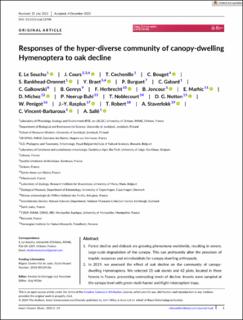Responses of the hyper-diverse community of canopy-dwelling Hymenoptera to oak decline
Le Souchu, Elodie; Cours, Jérémy; Bouget, Christophe; Bankhead-Dronnet, Stéphanie; Braet, Yves; Burguet, P.; Gabard, C.; Galkowski, C.; Gereys, B.; Herbrecht, Franck; Joncour, Barbara; Marhic, Erwann; Michez, Denis; Neerup Buhl, P.; Noblecourt, T.; Notton, David G.; Penigot, W.; Rasplus, Jean-Yves; Robert, T.; Staverløkk, Arnstein; Vincent-Barbaroux, Cécile; Sallé, Aurélien; Cochenille, T.
Peer reviewed, Journal article
Published version

Åpne
Permanent lenke
https://hdl.handle.net/11250/3110575Utgivelsesdato
2024Metadata
Vis full innførselSamlinger
- Publikasjoner fra CRIStin - NINA [2364]
- Scientific publications [1392]
Sammendrag
1. Forest decline and dieback are growing phenomena worldwide, resulting in severe,large-scale degradation of the canopy. This can profoundly alter the provision oftrophic resources and microhabitats for canopy-dwelling arthropods. 2. In 2019, we assessed the effect of oak decline on the community of canopy-dwelling Hymenoptera. We selected 21 oak stands and 42 plots, located in threeforests in France, presenting contrasting levels of decline. Insects were sampled atthe canopy level with green multi-funnel and flight-interception traps. 3. We collected a particularly diverse community of 19,289 insect individuals belong-ing to 918 taxa, 10 larval trophic guilds and 7 nesting guilds. 4. Oak decline had no effect on the abundance or richness of the overall communitybut significantly reshaped the community assemblages. Decline had contrastingeffects depending on the taxa and guilds considered. Specialist parasitoids weremore abundant at intermediate levels of decline severity while generalists werenegatively affected. Taxa depending on ground-related resources and microhabitatswere promoted. Saproxylic taxa were more abundant while xylophagous insectswere negatively impacted. 5. Reduced leaf area index promoted several guilds and the diversity of the overallcommunity. While an increasing tree mortality rate enhanced the abundance anddiversity of deadwood resources, it had negative impacts on several Hymenopteraguilds. Our results suggest that micro-environmental changes at the ground leveldue to canopy decline have major cascading effects on the communities of canopy-dwelling Hymenoptera.6. Our study highlights the relevance of studying Hymenoptera communities to inves-tigate the outcomes of disturbances on forest biodiversity. canopy openness, deadwood, habitat guild, temperate forest, trophic guild
